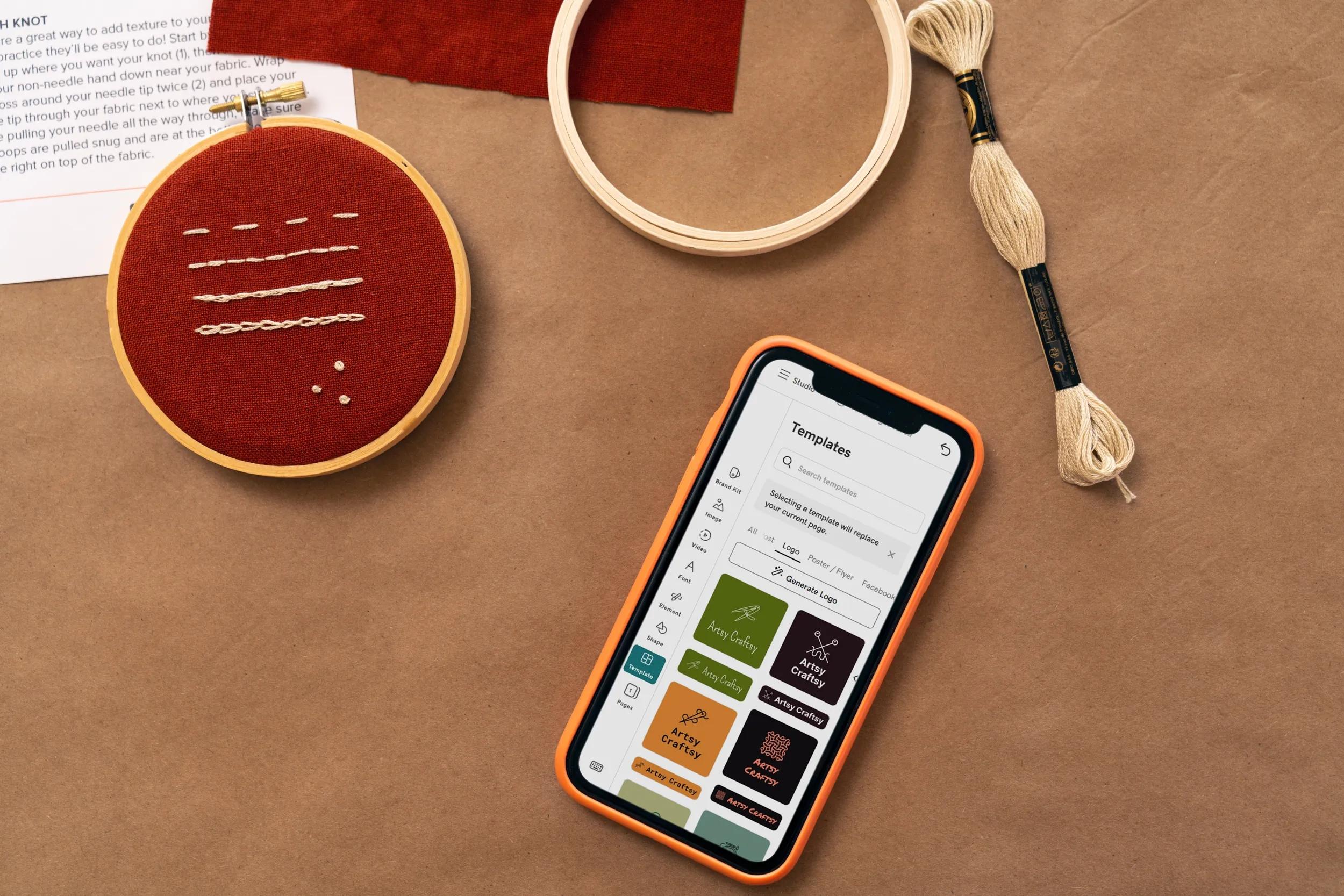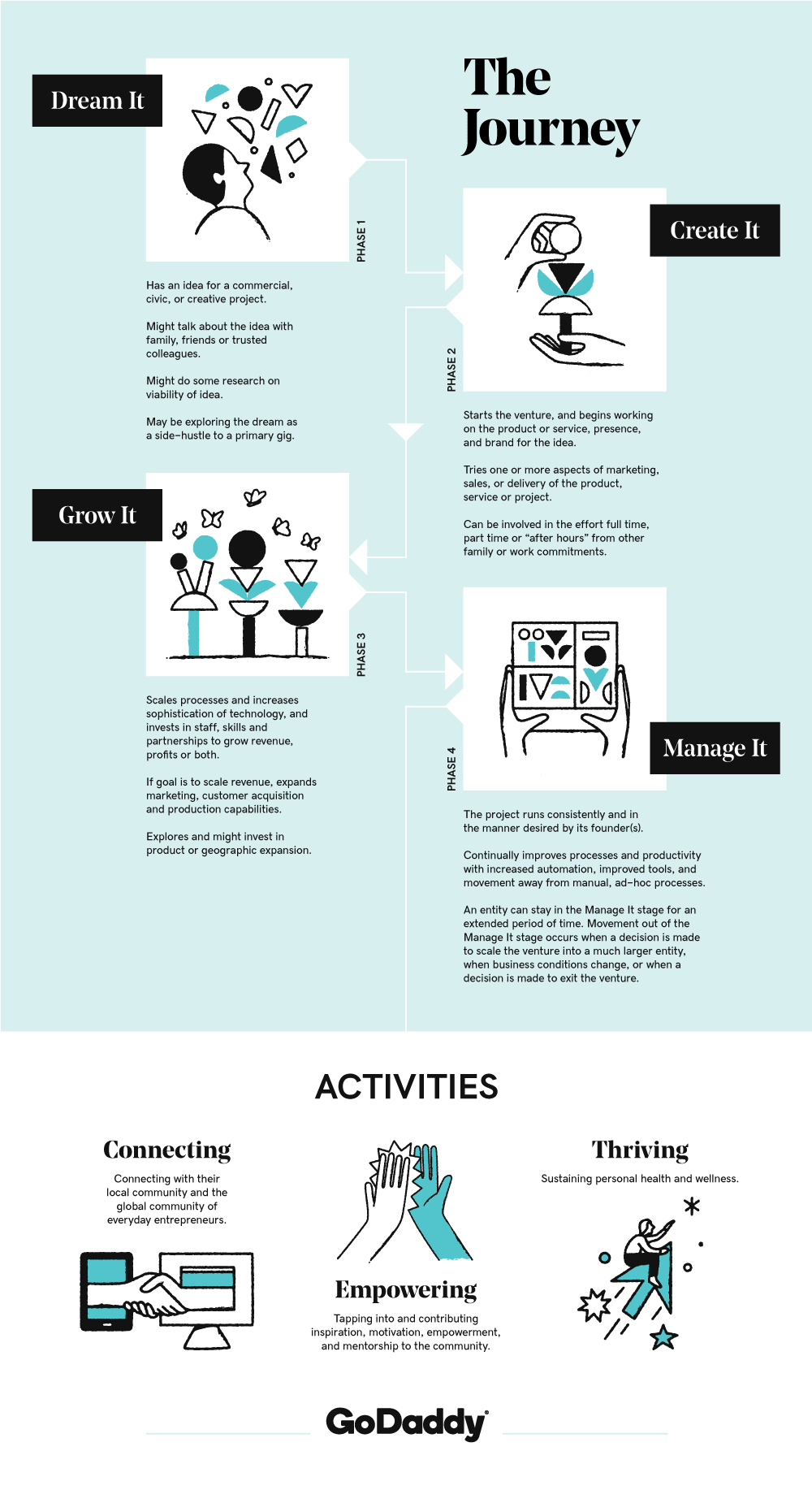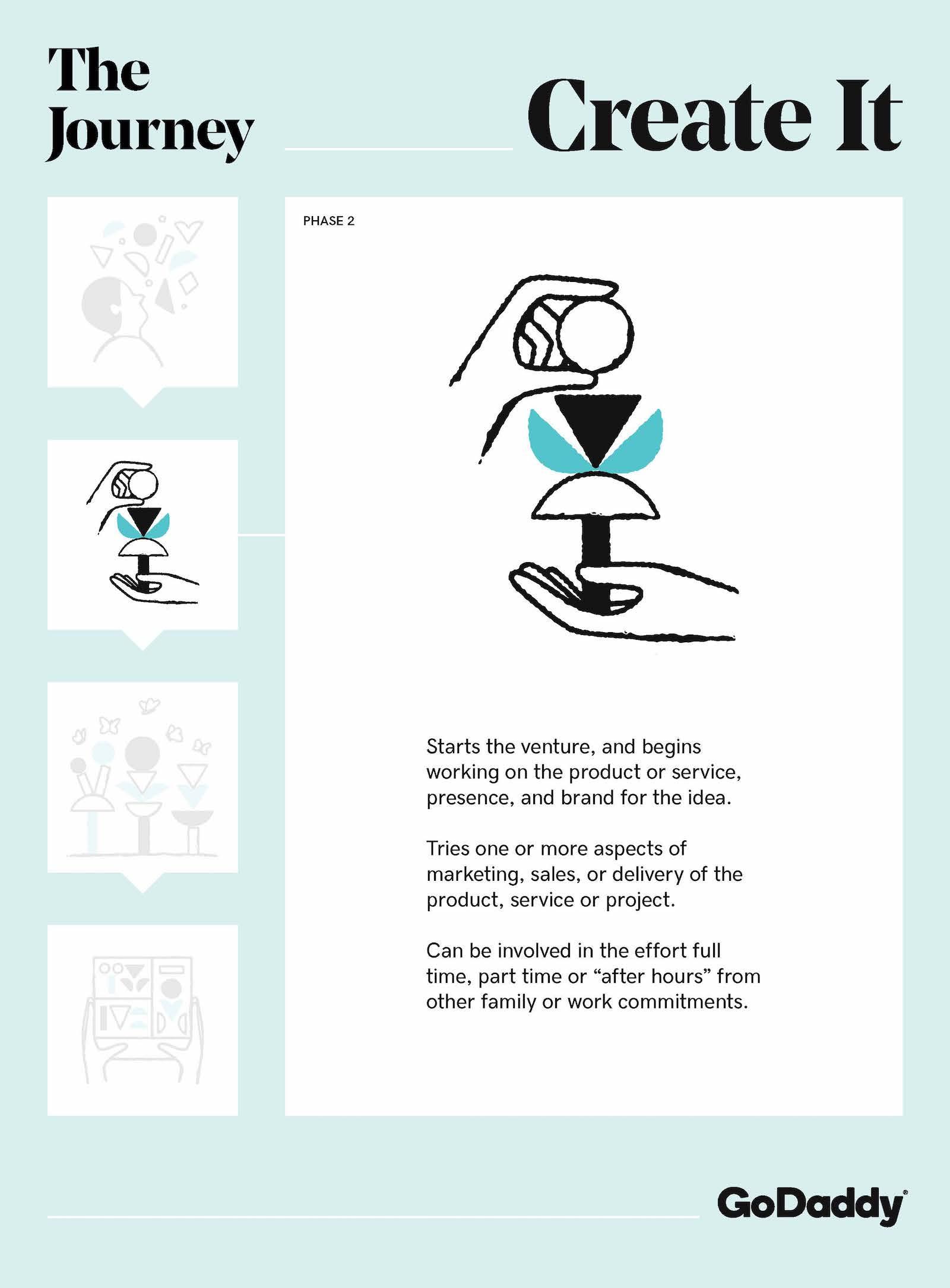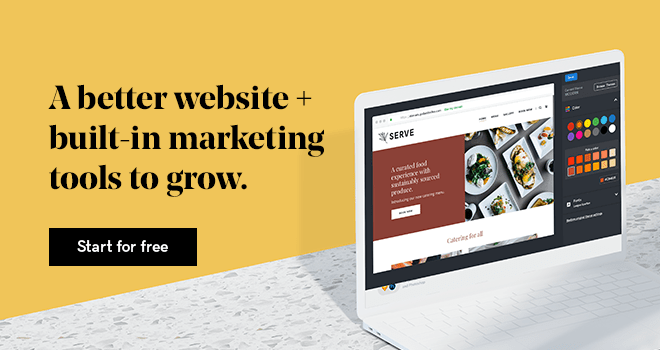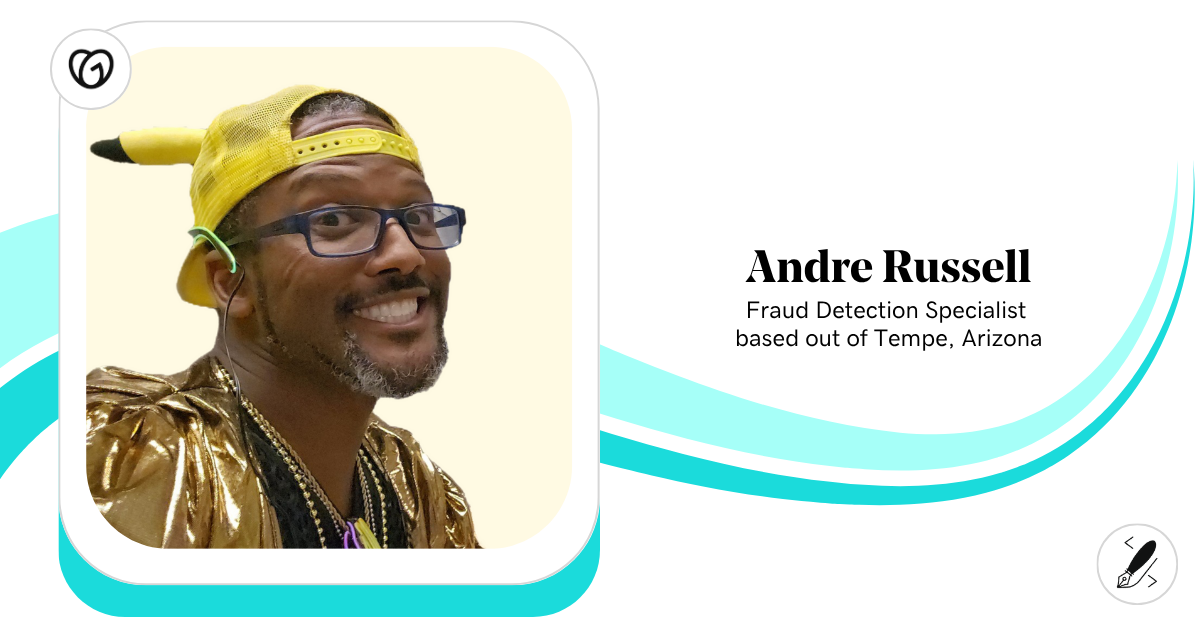This article is part of a multipart series. If you want to start at the beginning, that is where we define the entrepreneur journey in its entirety.
You have that world-shaping idea that you’ve been dreaming about. You know where you want to go and, in your mind’s eye, you’ve sketched out the key points of the path to get there.
Now take a deep breath. It’s time to move from dreaming to doing.
At this stage of the Journey, you need to create three key components to set a solid foundation for your future success: your presence, your brand and your product or service.
- Your presence is critical because your online presence is where your customers, prospects and extended community of supporters interact with you. Unless you solely have a brick-and-mortar set of interactions with your connections (that means no email, no website, no social media, no phone), your online presence literally is your connection to the rest of the world.
- Your brand is critical because your brand is a high-speed emotional shortcut to the promise you make to the world.
- Your product or service is critical because it’s how you deliver value to your customers or community. No product or service? No value.
As entrepreneurs, we often get most enamored by our idea for our product or service. This is totally normal!
The idea is the thing that drives us. It’s our creation; it’s our baby. But having a great product or service isn’t enough by itself.
Plenty of great products never achieved their potential because the market was unaware of them, or didn‘t understand their value, or didn’t see how they were different or better than the things that were already available.
Launching the triad of presence, brand and product are all part of the Create It stage of the Journey. These three components set the foundation for all that is built and done as the Journey progresses.
The stages in the Entrepreneur Journey
As a recap, there are four distinct stages of the Entrepreneur Journey that track the path from idea to maturity of a venture:
- Dream It.
- Create It.
- Grow It.
- Manage It.
The Create It stage of the Journey
The “Create It” phase of the Journey is the inflection point where “thinking” turns to “doing.” The Create It stage is where the initial creation of presence, brand and product takes place.
It’s important to remember that the Create It stage is a point on the Journey, and is not an end in and of itself. The path of the Journey is progressive and iterative.
In the previous article in this series on the Journey, we talked about the way that naming your idea breathes life into it. Now it’s time to take that idea and create the three things that will connect it to the world: your online presence, your brand and your product/service itself.
Related: Collection of resources for naming a business
Creating your online presence
Before the internet and other electronic communications networks, if someone wanted to connect with a business or other venture, they had to go there in person and show up at the shop to interact. In the early days of the internet, this was still more-or-less the case, with organizations setting up their websites and people going to them via their web browsers.
With the explosion of the web, public and private social networks, online marketplaces, messaging, and other ways that humans communicate and gather online, the model has shifted and turned 180 degrees.
Instead of everyone coming to you, you need to have a presence wherever a critical mass of your community is likely to want to connect with you. At the same time, you need to have a “home base” (your domain and website) you can control.
As an entrepreneur, where you need to be varies on a case-by-case basis.
It depends on where your customers and community are.
(Important! You don’t need to be everywhere at all times, but you do need to think about where are the right places to be now and also stake out a claim in the other places that you might want to go in the future to secure your brand there. For example, you might not choose to use Twitter today to connect with folks, but you’ll still want to at least secure your Twitter handle to both reserve it for future use if and when the time is right and also to prevent someone else from diluting your brand by taking that Twitter handle.)
5 basics elements to create an online presence
At a bare minimum, there are five things you need to create the foundation of your online presence to make sure people can find you:
- Your domain
- Your website
- Your professional email
- Your social media presence
- Your second phone number
While your domain and website are closely related to each other, they are different and you need both. (If you want to do a deep dive, here is everything you need to know about domain names.)
Conceptually, you can think of a domain like your street address and the website as your physical home itself. The street address (your domain) is how someone finds your location, and your website is akin to your actual home itself that exists at that address.
Like homes, websites can vary significantly in style, shape, size and purpose from one to another.
At a minimum, your domain name should represent your brand identity, and your website should be modern, cleanly-designed, work well, and look great both on desktop computers and mobile devices.
When setting up the foundation of your online presence, you’ll want to make sure that you are using a professional email address that is connected to your domain.
Having a professional email address is important for your brand. (We’ll talk more about branding in a bit.)
The reason for setting up a professional email address is trust.
If you were a prospective customer and you received an email from a bike shop, you’re much more likely to trust the bike shop if the email comes from ellen@wheelandspokes.com and less likely to trust the email if it comes from madddog1758@gmail.com, for example.

Securing your social media names (called “handles” in some places) is important because customers, prospects and community members are now everywhere online.
Instagram, Facebook, Twitter and a host of other networks are now the public square, and you need to have a presence there as well.
Where possible, try to get handles on the major social networks and have those handles match your domain name.
That way, your community can find you no matter where they are or, at a minimum, you prevent imposters from grabbing your name out from under you and diluting or impersonating your brand.
Similar to having a professional email address, part of your professional presence includes having a second, dedicated phone number for your venture, instead of giving out your personal number.
The reasons for this are twofold:
First, for credibility and trust reasons, you want to have a dedicated contact number that is for your venture. (This prevents the situation when you’re expecting a call from your sibling and the phone rings and you answer with “Hey, what’s up?” only to find out with a blast of adrenaline that it’s your largest, and very straight-laced, client on the other end of the line. Awkward.)
Second, you just don’t want to give out your personal number for privacy and security reasons.
Thankfully, it’s really easy to get a second number these days; you can just add one to your existing mobile phone via a second phone number app.
Creating your brand
Your brand connects the core of what you’re promising to deliver to your customers to a set of triggers that remind the customer of that promise.
Brand promise vs. brand reality
A portion of creating your brand is the colors and fonts and look of those interactions. A unique and distinctive visual branding provides a shortcut that reminds a customer of that promise every time they are exposed to the brand across various media.
More than the brand promise, however, is the importance of the brand reality — that is, the experience that customers have when they actually interact with you.
During the Create It phase, you set the tone for the first interactions with your venture — your brand — and those interactions and how they made them feel are what customers will share with others when they are asked about your brand.
As you create your brand, you also have some decisions to make.
- Who is your target market? Who are you serving?
- What are your goals for your venture?
- What can customers achieve by partnering up with you?
- What’s the personality of your brand? (Unsure? You can take a brand personality quiz to get some ideas.)
As you develop your brand during the Create It phase, you are creating the visual, mental and experiential model that will exist in your customers’ consciousness.
This model is the proxy for what customers believe you stand for, and what emotions your venture evokes when customers are exposed to it.

Creating your product or service
During the Dream It stage, you likely had a raft of ideas about your product or service. The Create It stage of the Journey is where you fashion its first versions and get it in front of customers.
As you start to interact with customers, remember that everything is iterative.
In many cases, physical objects can now be prototyped quickly either at home or via third-party services and presented to prospective customers for feedback.
Here’s a real-world example: I was recently at a gathering and started speaking with one of the other attendees, David, who described himself as a “part-time inventor.” David said he was currently working on a new way to rapidly create buildings and other structures for disaster recovery and other uses based on a new type of building block that he had designed.
The building blocks were a completely new design of the cinder blocks we have all seen. Instead of carrying around 35-pound bricks, however, he simply ran out to his car and came back with a shoebox filled with miniature samples of his design that were the size of LEGO that he had printed using a low-cost 3D printer to conceptually show how the system worked. It was very compelling.
Like David, as you create the first iterations of your product or service, you are looking to quickly get something in front of customers to gather their feedback and hone the idea.
Your product is not going to solve every problem right out of the gate, and it’s better to create a “minimum viable product” that solves a particular pain point for customers at first and add additional capabilities later.
At this stage, pragmatism and action need to take the lead.
This applies if you have a service as well. Find ways to cost-effectively get it in front of customers while keeping your infrastructure costs low.
The most important thing is to get your offering in front of customers to get feedback that enables you to iterate quickly and improve your offering to a point where it delivers so much value to them that people are clamoring for it.
Bonus resource: Slideshop’s Product Roadmap template
Slideshop’s Product Roadmap template, available via subscription, can help you create and present compelling first-time product roadmaps and persuasive short- and long-term product roadmap updates for both high- and low-stakes launches.
The PowerPoint template’s 22 professionally designed slides include:
- Presentation agenda
- Welcome from the CEO or other presenter
- About us
- Product overview
- Target market
- Survey / customer feedback results
- Company mission, vision, values
- A Venn diagram with the intersection of business needs and customer desires
- Details of a phased launch
- Timeline of the product launch roadmap
- Low to high priorities / areas of focus for launch week
- The opportunity in terms of the competition and your product / the new space
- A line graph showing potential ROI
- Demand generation activities
… plus supplemental charts and design tips.

It’s great to Create
If naming your idea is the place where it becomes “real,” creating your online presence, brand and product or service is the point on the Journey where things become really real.
While it’s easy to be focused primarily on the product or service that you’re creating, the other two components of the Create It phase — creating your presence and creating your brand — are equally important.
If customers can’t find you, don’t trust you, or don’t have a way to remember you, it becomes significantly more difficult as an entrepreneur to effect change in the world with your product. All three areas must gracefully work together for you to be set up for success.
Stay focused, do the work, and create!
Get yourself out there and connect with your first customers. Find ones who will give you solid, unfiltered feedback on all three of the areas discussed here. Iteration is the key to success in the Create It phase.
Create, ship, get feedback. Repeat.
Feeling good about your presence? Getting resonance with your brand? Are folks who aren’t friends or relatives starting to come to you for your product or service? Excellent! Now it’s time to move forward and into the Grow It phase of the Journey.

